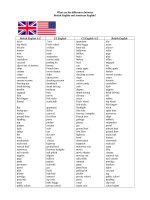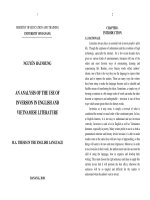ASSIGNMENT ON English and American Literature
Bạn đang xem bản rút gọn của tài liệu. Xem và tải ngay bản đầy đủ của tài liệu tại đây (115.38 KB, 10 trang )
HANOI OPEN UNIVERSITY
FACULTY OF ENGLISH AND MODERN LANGUAGES
~~~~~~~oOo~~~~~~~
ASSIGNMENT ON English and American
Literature
Title: revenge in hamlet
Hanoi, 2009
Part A:Introduction
In the 15
th
– 16
th
centuries capitalist relation began todevelop in
Europe.The former townspeople became the bourgeoisie.The bourgeoisie
fought against feudalism because held back the development of capitalism.
The decay of feudalism and the development of capitalist relation was
followed by a great rise in the cultural life of Europe.There was an attempt
at creating a new culture which would be free from the limitation of the
feudal ideology of the Middle Ages.The epoch was characterized by a
thirst for knowledge and discoveries,by a powerful development of
individuality.
There was a revival of interest in the ancient culture of Greece and
Rome(“Renaissance” is French for “rebirth”).The study of the works of
ancient philosophers, writers,and artists helped the people to widen their
outlook,to know the world and man’s nature.On the basis of both the
ancient culture and the most progressive elements of the culture of the
Middle Ages the fine arts,literature and science of the Renaissance began
to develop The culture of the Renaissance was,in fact,the first stage of
bourgeois culture.The bourgeoisie as a class was being born and,as Engels
said,the men who founded the modern rule of the bourgeoisie,had anything
but bourgeois limitations.
The progressive ideology of the Renaissance was Humanism.Human
life,the happiness of people and the belief in man’s abilities became the
main subjects in file arts and literature.The works of humanists proclaimed
equality of people regardless of their social origin, race and religion
.Humanism did away with the dark scholastic teaching of the Middle
Ages.The development of a new social order presented great possibilities
for man’s creative power .That is why the humanist outlook was with
bright optimism,with belief in man’s great abilities anh his high mission. It
was contrary to the medieval ideology and especially to that of the Catholic
Church.The power of Church over men’s mind was defeated.The bearers
of the progressive outlook greatly contributed to the development of every
branch of the world’s art,culture and science.
The most outstanding dramatist of the period, as well as of all time,
was William Shakespeare.He was born on April 23,1564 in the small town
of Stratford-upon-Avon,about seventy-five miles from London.He was the
son of a tradesman.When a boy he went to Stratford Grammar School
where Latin and Greek were almost the only subjects.Life itself,contact
with people and his acquaintance with the rich English folklore gave him
more than the scholastic methods used at school.In those says Stratford-
upon-Avon was often visited by travelling groups of actors.It is quite
possible that Shakespeare saw some plays performed by such actors and
was impressed by them.
Shakespeare lived in Stratford-upon-Avon until he was twenty-one.By
that time he was married and had three children.At twenty-one he left
Stratford-upon-Avon for London where he joined a theatrical company and
worked as an actor and a playwright.
In the late 90s a new theatre called The Globe was built on the bank
of the Thames.Shakespeare became one of its owners.The people of the
London liked it better than any other theatre.It was in The Globe that most
of Shakespeare ‘s plays were staged at that time.
In 1613,Shakespeare left London and returned to his native town of
Stratford-upon-Avon.Three years later,on April 23,1616,he died and was
buried there.Shakespeare wrote the famous 154 sonnets and numerous
highly successful often quoted dramatic works including the tragedy
“Hamlet, Prince of Denmark.”.
Shakespeare’s Hamlet is a complex play where many themes are
intertwined – themes that are essential to the development of the play. The
issue of death and disease, both physical and emotional is very prevalent
throughout the duration of the play, as well as fate and divine providence.
The play also questions madness and whether it can be feigned, as well as
corruption and its moral implications. Of course, who could forget the
famous ‘To be or not to be’ soliloquy, where Hamlet not only questions
life and death, but many of life’s other uncertainties as well.
Undoubtedly, the most essential theme in the development of
Hamlet is revenge and question ‘Does revenge pay?’ Revenge is a
frighteningly bloodthirsty emotion, which causes people to act blindly and
without reason. Revenge is a theme that is cleverly built upon throughout
the extent of the play; with it being the driving force behind two of the
main characters in the play.
Part B:Development
I.Summary of the work.
Hamlet,written around 1600,is Shakespeare’s longest play,and among
the most powerful and influential tragedies in the English language.It
provides a storyline capable of “seemingly endless retelling and adaption
by others”.The play,set in Denmark,recounts Prince Hamlet mourns both
his father’s death and his mother,Queen Gertrude’s remarriage to
Claudius.The ghost of Hamlet’s father appears to him and tells him that
Claudius has poisoned him.Hamlet swears revenge.He arranges an old play
whose story has a parallel to that of Claudius. Hamlet’s behaviour is
considered mad.He skills the eavesdropping Polonius,the court
chamberlain,by thrusting his sword through a curtain. Polonius’s son
Laertes returns to Denmark to avenge his father’s death.Polonius ‘s
daughter Ophelia loves the Prince but his brutal behaviour drives her to
madness.Ophelia dies by drowning.A duel takes place and ends with the
death of Gertrude,Laertes,Claudius and Hamlet.
II. Analysis
The play is introduced by the appearance of the ghost of Hamlet’s
father in the first scene, which automatically gives the impression that
something is amiss. This is later clarified by the statement that
“Something is rotten in the state of Denmark”
(Act 1 Scene 4)
The ghost emerges before Hamlet and insinuates that his death was not as
innocent as it may seem. The ghost urges Hamlet to
“Revenge his foul and most unnatural murder”
(Act 1 Scene 5)
and informs him that
“The serpent that did sting thy father’s life now wears his crown”
(Act 1 Scene 5)
This appears to indicate that Hamlet’s father’s death was actually murder,
and that the deed was committed by King Hamlet’s brother, Claudius, who
had now taken over as King of Denmark. The Ghost taunts Hamlet, telling
him that it is part of every man’s honor to avenge his death. Hamlet then
becomes a part of Denmark’s foulness and wretchedness when he agrees to
avenge his father’s death. This is the beginning of a vicious cycle of
hatred, death and revenge that destroys many lives.
Soon after Claudius marries Hamlet’s mother, Gertrude, Hamlet
feigns madness as a ploy to cover up his attempts to avenge his father’s
death and to bring him closer to Claudius. One of the first things Hamlet
does in his attempt to prove Claudius’ guilt is to have ‘The Mousetrap’
performed in court. ‘The Mousetrap’ recreates a similar scenario as the one
that had occurred when Hamlet’s father was murdered. Hamlet was
waiting for a reaction from Claudius that would prove the ghost’s message.
Following the King’s outburst after watching the performance,
Hamlet confronted his mother and began to insult her infidelity to her dead
husband. Meanwhile, Polonius, a faithful member of the King’s council,
was hiding behind a decorate rug that was adorning the wall in Gertrude’s
room. Hamlet sensed his presence and thinking that it was Claudius,
plunged his dagger through the rug.
This causes much grief and sadness for many people. During this
period, Hamlet treats his ‘girlfriend’ Ophelia (Polonius’ daughter) in a
shocking manner, calling her a whore and denying her his love. This,
coupled with her father’s death causes her to go mad and eventually
commit suicide. This was a particularly sad death because Ophelia was just
an innocent bystander in a cruel plot for revenge. Also hurt was Laertes
(Polonius’ son). Laertes believes that it was the king that killed his father,
but the king quickly puts Laertes on Hamlets trail and pushes him to
avenge his fathers murder. From this point on, Hamlet and Laertes become
the main characters in the play - two characters driven by revenge.
Meanwhile, Hamlet is still talking about all his plans for revenge.
During act 2, Hamlet realizes his acts of revenge so far have been through
word rather than deed.









